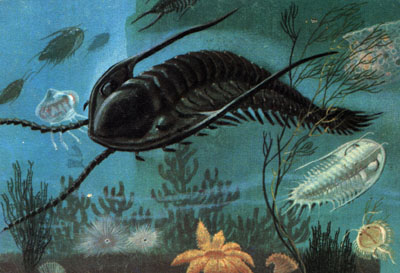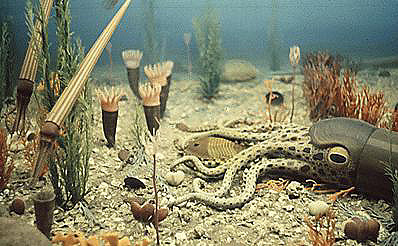PALEOZOIC 543-248mya
While life first began in the Precambrian Seas the Paleozoic Era saw a rapid proliferation of life both in the seas and on land. While the flora and fauna that evolved and developed over this time period may seem alien, every living thing on the Earth today can trace its origins back to these sometimes savage seas.
Cambrian - 550 - 500 mya
Oceans warm and shallow
Notable critters: Cambrian explosion – Before the Cambrian life was mostly small and simple.
- First chordates
- Eyes develop
- Beginning of armored plating in all types of life - calcification
- 535 mya first trilobites, echinoderms and arthropods
- 545 mya first mollusks
- Possibly first fish (still disputed)
Notable Plants:
- No land plants
Cambrian ended with the third in a series of extinction events.
- Botomian Extinction event – 517 mya
- Dresbachian extinction event – 502 mya
- Cambrian – Ordovician extinction event – 488 mya –
- Wiped out 60% of all genera
- Eliminated brachiopods and conodonts.
- Possibly caused by glaciations and anoxic conditions in oceans.
O2 levels 68% of today
Very high sea levels
Southern continents combined into a super continent called Gondwana.
Notable Critters:
- Trilobites still rule and dominate the mid-Ordovician
- Appearance of first jaws
- Lots of animals growing shells including the mollusks especially bivalves, gastropods, and nautiloid cephalopods
- Increase in filter feeding implies large plankton presence
- First coral reefs
- First jawed fish in Late Ordovician
Notable Plants:
- First land plants. Possibly evolved from marine algae, appeared as mosses
Ended in Mass Extinction 450 mya
- 2nd largest extinction event, 46% of all genre died including trilobites, brachiopods and bryozoans
- Some suggest a gamma ray burst destroyed the ozone layer triggering the Ice Age.
Silurian 443 – 416 mya
O2 Levels 70% of today
Surface temp 3C higher than today
Sea Level 180m higher than today
Super continent Gondwana still present
Notable Critters
- First bony fish, Osteichthyes such as Acanthodians
- Massive arthropods such as Eurypterids
- Food web implies presence of detritovies which have yet to be discovered
Notable Plants
- First macrofossiles (fossils of ecosystems) such as terrestrial moss forests
- First vascular plants
Devonian 416-359 mya
Named after Devon, England
O2 75% of modern level
Surface temp 6C higher than today
Sea level 180-120m above today
Super continent of Gondwana still dominant
Notable Critters: Age of Fish
- 397mya Amphibian beginnings - Lobed-finned fish developed legs and became the first tetrapods
- 400mya Ammonite Mollusks appear
- 416 mya First fossils of insects on land
- Jaw-less armored fish in decline
- Dunkleosteus – Strongest bite force the world has ever known
- Various arthropods also took to land
 |
| Dukelosteous |
- Cladoselache - Primitive chondrichthyes (such as sharks) diversity and dominate
- Trilobite still prevalent
- Large reefs built by calcareous algae, coral-like stromatoporoids and tabulate and rugose corals
Notable Plants
- First seed-bearing plants forming forests
- Rooting plants created the first stable soils which began to harbor anthropoids such as mites. Insects and seed bearing plants co-evolved and defined plants of the late Devonian. Pollen and pollinators co-evolved.
- Primitive rooted plants
- Primitive leaves
- Primitive trees
- Prototaxites – greatest land organism, fruiting fungus
- Archaeoperis – ferns began forming primitive trees
Late Divonian Extinction – 364 mya
- All fossil agnathan fish disappeared
- Primarily effected the marine community especially shallow warm water creatures such as the reef builders
- Brachiopods, trilobits, ammonites, condonts, acritarchs and jawless fish severly affected
- Reasons still unknown – theories include asteroid impact and climate change from CO2 sequestered from the plant life on land.
Carboniferous
O2 163% of todays levels
Surface Temp same as today
Sea levels fluctuated from +120m to 0 to +80m above current sea levels
Notable critters
 |
| Sethacenthus - Early shark. |
- Marine invertibrates
- Sponges flourished
- Reef building and solitary corals flourished.
- Nautaloid cephalods numerous - straight shells more common than coiled shells -ammonites common
- Gastropods - primarily snails common
- Freshwater fish established
- Sharks very diverse - filling niches left by declining placoderm populations
- Sharks take many odd shapes
- Sethacanthus
- Large, air breating insects diversified and gigantified thanks to high O2 levels - size limited by oxygen able to be absorbed dermally.
- Amphibians also giant - up to 2 meters long! Populations began to decline as the rainforests collapsed.
- Reptiles out competed amphibians as the land dried out due to harder less permeable shells on their eggs and their impermeable scales.
- First Synapsids - led to mammals
- First Sauropods - led to birds and dinosaurs
Notable Plants
- Main plants - Horsetails, ferns, vines, club mosses
- Large tree like ferns
- First appearance of bark bearing trees and the evolution of lignins. These trees had up to 10:1 bark to wood ratio as opposed to modern trees which have around 1:4.
- North America mostly swamp land: bacteria and fingus had not yet evolved to digest the newly evolved lignin in the tree bark. It has been hypothesized that the coal laid down in this time is from these trees, which rather than being decomposed and recirculated, as they would be now, sequestered the carbon in the ground. This reduced the amount of CO2 in the atmosphere and created global cooling.
Ended in Mass Extinction (Noticing a pattern yet?) : Carboniferous Rainforest Collapse - 300mya
- As trees died but were not decomposed by bacteria, large amounts of carbon were sequestered in the ground. Decreasing CO2 levels caused a global cooling which triggered an ice age. Sea levels dropped, the land dried off, rainforests died out.
- Pretty much the opposite of what is happening right now to us.
Permian Period 299-251 mya
O2 levels 115% of today
Surface Temp 2C above today
Sea Levels 60 above today to -20m of today.
Pangea Rules - massive desert with little shoreline
Notable Critters
- Trilobites finally go extinct - had a good run
- On land tetrapods begin to rule - first large herbivores and carnivores on land.
- Early Permian - pelycosaurs - early synapsids
- Dimetrodon – with two types of teeth, unique to mammals – predarorty
- Middle Permian - therapsids – mammal like reptiles
- Dinocephalia – large carnavores
- Late Permian – more advanced therapids
- Gorgonopsian
- Dicynodonts
 |
| Gorgonopsian |
Notable Flora
· Many of the main plants from the carboniferous dies during the CRC making way for different varieties of plants.
· Flora of the swamp gave way to more confiers and seed bearing plants, such as ferns, which could survive the intense heat and droughts in the centers of Pangea.
· Ginkos and cycads appeared.
Ended in Extinction: Permian-Triassic Extinction –
· 90-95% of all marine species became extinct
· 70% of all land organisms
· Only known mass extinction of insects
· Sudden 5C rise in world temperatures
· Theories include:
o Basalt eruptions in Siberia
o Release of submarine methane causing extreme global warming
o Release of submarine hydrogen sulfide creating anoxic marine environments which suffocated the life there before creating an toxic atmosphere and destroying the ozone layer.
· Land locked areas took as long as 30million years to recover


No comments:
Post a Comment